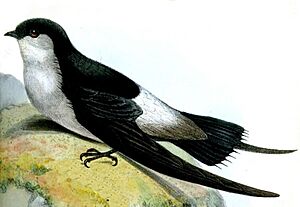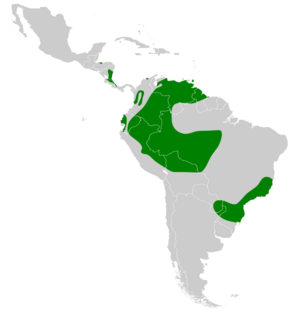Grey-rumped swift facts for kids
Quick facts for kids Grey-rumped swift |
|
|---|---|
 |
|
| Conservation status | |
| Scientific classification | |
| Genus: |
Chaetura
|
| Species: |
cinereiventris
|
 |
|
| Synonyms | |
|
Acanthylis cinereiventris |
|
The grey-rumped swift (Chaetura cinereiventris) is a type of bird known for its fast flight. It belongs to the swift family, Apodidae. You can find this bird in many places, including Honduras, Nicaragua, Costa Rica, and Panama. It also lives in most countries in South America, like Colombia, Ecuador, Peru, and Brazil. You can even spot it on islands like Trinidad and Tobago and Grenada.
Contents
About the Grey-rumped Swift
Different Types of Grey-rumped Swifts
Scientists group animals into different types. The grey-rumped swift has seven subspecies. Think of subspecies as slightly different versions of the same animal, often living in different places. Here are their scientific names:
- C. c. phaeopygos
- C. c. lawrencei
- C. c. schistacea
- C. c. guianensis
- C. c. occidentalis
- C. c. sclateri
- C. c. cinereiventris
Some scientists have different ideas about how these swifts are related to each other. For example, some think the grey-rumped swift and the pale-rumped swift might be the same species. Others believe some of the grey-rumped swift subspecies might actually be a separate species.
What Does the Grey-rumped Swift Look Like?
The grey-rumped swift is a small bird, usually about 10.5 cm (4.1 in) long. It weighs around 17 g (0.60 oz), which is about as much as a few coins.
This swift has a head that sticks out a bit and a short, square-shaped tail. Its wings are special; they bulge in the middle and curve at the ends, almost like a hook. Both male and female grey-rumped swifts look alike.
Most adult grey-rumped swifts have shiny black feathers on their upper body. They have a wide gray patch on their rump (the lower back) and on the feathers covering their upper tail. Their belly feathers are a lighter gray than their rump. Young swifts look very similar to adults, but they might have pale edges on some of their wing feathers.
The different subspecies have small differences in their colors. For example, some have darker bellies, while others have blacker undertail feathers.
Where Do Grey-rumped Swifts Live?
Grey-rumped swifts live in various places across Central and South America, as well as some Caribbean islands. Each subspecies tends to live in a specific area:
- C. c. phaeopygos: Found in northeastern Honduras and from eastern Nicaragua through Costa Rica into northwestern Panama.
- C. c. lawrencei: Lives in northern Venezuela, Trinidad, Tobago, and Grenada.
- C. c. schistacea: Found in the Andes mountains, from western Venezuela into eastern Colombia.
- C. c. guianensis: Lives in eastern Venezuela and western Guyana.
- C. c. occidentalis: Found from western Colombia through western Ecuador into the very northwestern part of Peru.
- C. c. sclateri: Lives in scattered areas in southern Venezuela, southern Colombia, northwestern Brazil, eastern Peru, and northwestern Bolivia.
- C. c. cinereiventris: Found in southeastern Brazil, eastern Paraguay, and northeastern Argentina.
These swifts can live in many different types of environments. They like tropical forests that stay green all year, mountain forests, and even forests that flood sometimes. They can be found from sea level all the way up to 1,800 m (5,900 ft) high in the mountains.
Grey-rumped Swift Behavior
Migration
Most grey-rumped swifts stay in the same area all year round. They are considered "residents." While some might move around a bit in places like Paraguay and Argentina, there's also evidence that they live there all year too.
Feeding
Like all swifts, the grey-rumped swift catches its food while flying. It eats insects in the air. These birds often hunt in groups, usually with 20 to 40 other swifts. Sometimes, they even join flocks with other types of swifts or even swallows. Their diet includes flying ants, bees, wasps, beetles, and flies.
Reproduction
The breeding season for the grey-rumped swift changes depending on where they live. For example, in southeastern Brazil, they breed between September and March. In Costa Rica, it's from March to July.
These swifts build a special nest that looks like half a cup. They usually attach it to the inside wall of a chimney or a similar tall, narrow structure. They might even fix up and reuse their old nests. Both parent birds take turns sitting on the eggs at night. A female swift usually lays two to four eggs. We don't know exactly how long it takes for the eggs to hatch or for the young birds to be ready to fly.
Vocalization
The grey-rumped swift makes a few different sounds. One common call is a bright, short "tsip" sound that it repeats. It also makes a series of three or four slightly downward-sloping, drawn-out notes that sound like "trrreeew-trrreeew-trrreeew." The calls of the other subspecies are similar but might have slight variations.
Status of the Grey-rumped Swift
The IUCN (International Union for Conservation of Nature) has looked at the grey-rumped swift and decided it is a species of "Least Concern." This means they are not currently worried about it becoming endangered.
This swift lives across a very large area, and there are an estimated 50 million adult birds. While the population seems to be slowly decreasing, scientists haven't found any immediate major threats to the species. It's considered one of the most common types of Chaetura swifts in its range, and it lives in several protected areas.


